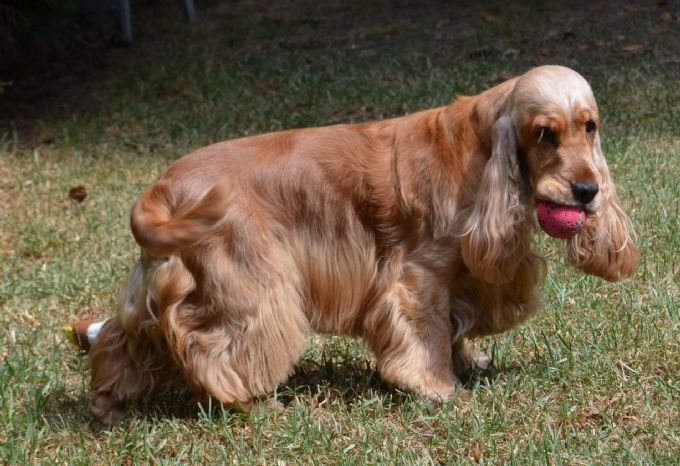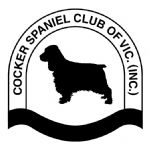GROOMING

GROOMING
The cocker spaniel is classed as a silky haired breed and it’s beautifully long, silky coat is a striking feature. But that beautiful coat isn’t the easiest to manage and as such the cocker's coat requires considerable time and commitment to keep it looking good. Their coat needs regular brushing to ensure that it doesn’t become mattered and tangled. It is very important that your dog becomes use to being brushed and groomed from a young age so that it becomes an enjoyable and familiar experience.
A silky haired breed has shorter fur on their face, head, body and on the front of their front legs and longer hair or feathering on their ears, chest, back of their front legs, under carriage, back legs and tail.
But grooming your dog isn’t just about keeping them looking good. It is essential to your pet’s health as it also provides the ideal opportunity to look for fleas and ticks, sores or lumps, skin problems, grass seeds, burs and matting.Grass seeds can work through the fur down to the skin where they set up irritation, pain, and infection. Matted fur can hide injuries and lead to infections. It is easier to miss thorns or bits of debris that are stuck to them.
It is recommended wasing your dog every 1-2 weeks, especially if the feathers are long. If you use a good quality product and rinse it out carefully, there is no chance of damaging the coat or skin.
NOTE: Do not use human shampoo as our skin has a different PH level to dogs.
How often should you Groom a Cocker Spaniel?
There is nothing nicer than a well groomed Cocker Spaniel but it's easy for their coat to get out of control.
You should groom your Cocker Spaniel every three days to keep them looking good. However, if you like to walk your dog in the park with undergrowth, you may need to brush them more often than this as they will probably pick up grass seeds, burrs, and other debris while out exercising.
If you find that your brush is picking up lots of loose hair, increase your grooming frequency to every other day or even every day.
If your brush isn’t picking up much hair, you can reduce grooming to once or twice a week.
Grooming During the Shedding Season
Cocker Spaniels are moderate shedders and their main shedding seasons are in spring and autumn, coinciding with the change in daylight hours and temperature. During shedding season, you should groom your Cocker Spaniel every day as this will help prevent matting and also prevent your furniture from becoming upholstered in dog hair.
How to Groom a Cocker Spaniel
Brush small sections of your dog’s coat at a time, working in the direction of hair growth. Try not to pull on the hair, especially when working on detangling mats.
The difference between a knot and a matt is that a knot can be brushed out whereas a mat is stuck to the skin and requires a lot more work to remove. Mats are lumps of shed undercoat that has not been brushed out. If your cocker spaniel wears a harness, then they may be prone to matting in areas where the harness rubs across the fur. You must remove all the matts to ensure that there are no grass seeds embedded in them.
Begin by gently teasing out mats using your fingers. Then use a matt breaker, working carefully to break the matt apart. Try to keep your fingers between the skin and the matt to help prevent pulling on the skin.
Next, use a slicker brush to go over the whole dog. The slicker brush will get rid of any loose hair.
Finish the job by brushing your dog with a soft-bristled brush to lift off any loose hairs that have been left on the top of the coat.
Equipment
Slicker Brush
This is an extremely useful brush as it has thin metal wire tines that work down into the dog’s fur, helping to untangle knots, remove dead hair and aid in reducing shedding. Brush in the direction the hair is growing, paying particular attention to the ears, under the arm pits and back legs where knotting and matting can occur. A slicker brush is essential for daily grooming.
Source: clipperworld.com.au
Metal or Rubber Pin Brush
The pin brush is ideal for cockers as it can penetrate deeper into the coat. It helps remove dead hair and thick undercoat.
Source: pinterest.com
Soft Bristle Brush
A soft bristle brush is ideal for lifting loose hair from the top of the dog’s coat when you’ve finished with the slicker brush.
It is also ideal for grooming a puppy. Using this type of brush regularly will help familiarise a young pup with other grooming tools once he is older. Grooming from an early age will make the whole process easier.
Get your puppy accustomed to lying down on a non-slip surface. Always elevate your dog on a table, bench or even something like the top of a washing machine. Teaching him to lie down for grooming needs patience and you need to start teaching the pup from about 4 months. Follow these tips to teach your puppy to lie down – lie the puppy on its side and gently place some of your body weight on him, gently stroking him repeating “good puppy”. Start with a few seconds at a time so as not to frighten him and build up slowly to longer times. This makes grooming the whole dog so much easier to manage and makes it a lot easier to groom problem areas such as under arm pits.
Remember brushing should be a pleasure not a chore.
Source: ebay.com
Steel Comb
This is useful especially AFTER using a slicker or pin brush as it will help ensure that any small knots or tangles are removed.
Source: amazon.com
Matt Breaker
Dematting tools aid in breaking up a matt. It slices the matt into strips so that each section can be worked on with a slicker brush or comb.
Source: amazon.com
Grooming Thumbs
If hand stripping a cocker's coat, you will need either rubber gloves or rubber thumbs. The rubber thumb helps to grip the hair between your finger and thumb to make hand stripping easier.
Source: kogan.com
However, it is only for the keenest of pet owners who want to learn to groom their own dog as it takes dedication and time especially in the first 12 months. You must start your puppy young as to get him used to the feeling.
Stripping Comb or Coat King
If you do not wish to hand strip, a Stripping Comb or Coat King can be used to remove excess coat instead. Always follow the direction the hair grows.
Source: mypetservices.com.au Source: petsonthepark.com.au
Cutting Scissors
A good pair of 7" inch scissors can be used to trim the body and leg feathers as well as the feet. You can also buy shorter round end scissors for trimming areas around the face
Source: ebay.com
Source: amazon.com
Thinning Scissors
These are used for more detailed trimming to thin and blend hair on the neck, under the ears, chest, shoulders, head and back leg feathering.
Source: staysharpshears.com
Clippers
Groom the ears and throat with a #10 Blade.
Always go with the direction of the growth of hair not against it as this can cause clipper burn and irritation. Scissors can be used around the opening of ear to keep it free of hair so the ear can breathe. Be very careful around this area as to not cut the skin. The head may be clipped with a #10 blade. If the dog is clipped this looks fine. Thinning scissors or hand stripping will give the head a more natural look.
For those owners who do not have the time or the inclination to cope with a coated breed, clippering and scissoring the coat is an easier alternative.
There is no wrong or right way if your dog is a pet (not used for showing) The coat must be easy to manage so your dog can fit into your lifestyle. It is much better to have an easy to manage coat and one that is clipped regularly rather than one that is long, tangled and matted.
Source: amazon.com.au
Cocker’s Ears
When grooming your dog’s ears, gently comb away any matting under and behind each ear, and then brush the leathers. That’s where most of the mats will be found.
Using a pair of trimming scissors, carefully trim away excess hair near the inner ear. Use a slicker brush to get rid of any loose hair from the leathers.
Finish off by combing to remove stubborn undercoat, starting from the bottom of the ear and working your way up.
Cocker Spaniels have long ears which can be heavy with a lot of hair at the opening of the ears and underneath.
The hair can prevent fresh air from reaching the ear canal, creating a moist area where bacteria may proliferate.
Check for any odour or discharge (dark brown or yellow in colour) as this may be the cause of an infection and will require attention by a vet.
The ear should only be cleaned if it looks dirty as over cleaning can cause the ear some trouble and irritation. You can clean the ear out with some ear cleaner from your veterinarian every month using cotton wool balls. Never use cotton sticks as this can be dangerous if put too deep in the ear. See your groomer or veterinarian for correct ear cleaning technique.
Feet
Your dog’s coat and feet can be easily maintained in-between grooms by brushing regularly and trimming feet when hair grows too long. Feet can be a problem with Cockers if neglected as in spring and summer they attract grass seeds which find their way into the skin and can travel up the leg and in winter long feet pick up the mud and moisture causing matting and impacted hair under the foot.
Sources:
Andrea Dolphin
